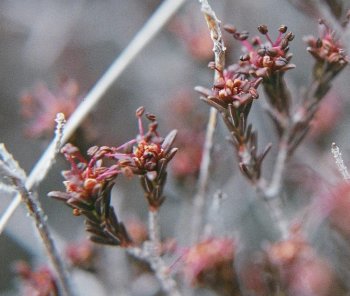Corema conradii
  |
 |
Photos courtesy Renee Brecht |
Britton & Brown |
| Botanical name: | Corema conradii (Torr.) Torr. ex Loud |
| Common name: | Broom crowberry |
| Group: | dicot |
| Family: | Empetraceae |
| Growth type: | subshrub, shrub |
| Duration: | perennial |
| Origin: | native |
| Plant height: | 4-8" |
| Foliage: | 30 cm in New Jersey; taller in Nova Scotia and Newfoundland |
| Flower: | purplish-red flowers, very tiny flowers that are dioecious (individual flowers are either male or female, but only one sex is to be found on any one plant) |
| Flowering time: | March to early April; fruit is small drupe with 3-5 nutlets. |
| Habitat: | coarse, gravelly, sandy, or rocky
soils and well drained soils that have been subjected to many years of grazing or fire |
| Range in New Jersey: | southern New Jersey Pine Barrens and Pine Plains |
| Heritage ranking, if any: | S1, Endangered, Listed Pinelands |
| Distribution: |  |
| Misc. | Office of Natural Lands Management - Publications lists as "disjunct populations usually along
the coast from Nova Scotia and Newfoundland to the New Jersey Pine
Barrens. Extant populations of C. conradii occur in Quebec,
Newfoundland,
Massachusetts, Maine, New York and New Jersey. " The habitat of the Pine Plains was described by Redfield (1889): "The region is a remarkable one, which cannot fail to impress every visitor with a sense of loneliness and sterility...these so-called "plains" are long undulating swells of sand, sometimes rising to a height commanding extensive views in every direction over a desert of sand so sterile that even the trees of Pinus rigida, which sparsely clothe it, can attain only to the height of three or four feet. No sign of human life is visible and one could readily imagine himself in the midst of a vast wilderness." It is this habitat in which Corema conradii lives. Corema, "a broom", from the bushy aspect, and conradii, after Solomon White Conrad, (1779-1831) who first discovered it. May be confused with Hudsonia ericoides, which is a yellow-flowered plant associate of C. conradii. |